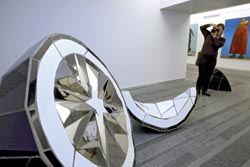Sluggish start under golden umbrella
Kyiv’s PinchukArtCentre opened an exhibition of 20 nominees for its own prize
The exhibition displays over 110 works. The final competition is among individual artists, such as Myroslav Vaida, Artem Volokitin, Andrii Halashyn, Hamlet Zinkivsky, Mykyta Kadan, Zhanna Kadyrova, Maya Kolesnyk, Volodymyr Kuznetsov, Lada Nakonechna, Oksana Protsenko, Oleksii Sai, Oleksii Salmanov, Olesia Khomenko, Oleksii Khoroshko, Ivan Chubukov, and Masha Shubina, and among the art groups Bluemoloko, Shapka, SOSka, and SYN. The exhibit, located on the third and fourth floors of PinchukArtCenter, will remain open for a month. The winners are to be announced on December 4.
The winners of the two special prizes will receive a cash award of UAH 100,000 and UAH 25,000, respectively, as well as an opportunity to do a month-long advanced studies course at the studios of world-famous artists Andreas Serrano in New York, Olafur Eliasson in Berlin, and Antony Gormley in London. The winners will be named by an international jury consisting of Francesco Bonami, art director of Fondazione Sandretto Re Rebaudengo (Turin); the Ukrainian-born photographer Sergei Bratkov (Moscow); Udo Kittelmann, director of the New National Gallery (Berlin); the world-famous Ukrainian photo artist Borys Mykhailov (Kharkiv—Berlin); and Jessica Morgan, curator of the prestigious London gallery Tate Modern.
The winner in the additional nomination Audiences Prize will be chosen by the vote of prize exhibition visitors.
Finally, the winners will receive awards from the hands of British artist Damien Hirst who is coming to Kyiv for this purpose.
Concurrently, the center is hosting the Red Woods exhibit which displays over 40 paintings, photo pictures, and video installations by the 1990s Ukrainian postmodernists Serhii Bratkov, Oleksandr Hnylytsky, Oleksandr Roitburd, Arsen Savadov, Heorhii Senchenko, and Vasyl Tsaholov.
As for the young nominees, they resemble their senior colleagues in many ways – not so much by style as by the way of thinking, which still clings to conceptualistic and postmodern standards.
The Kyiv-based Bluemoloko mark the environment with stenciled national ornaments and display photo reports on these exercises.
Also focusing on photography is the Kharkiv-based Artem Volokitin, who showed the rather provocative pictures of naked boys and girls in the “Teenagers” and “Hero” series.
And here are photos by Oleksii Salmanov, a native of Rostov-on-Don and now a resident of Kyiv. They are in a low key, black and white, and have a social content of sorts: in “Blackout—China” the face of a young Chinese is gradually ousting that of his European peer from the view.
On the contrary, pictures of the Mukacheve-Kyiv-based Shapka are colored and play-acted: the “Life” and “Our Family Portrait” series are about what can be called humanoids who live, marry, and are born with gas masks on.
Andrii Halashyn, a Lviv resident who now lives in Costa Rica, paints canvases which combine pop art collages with anarchic abstractions in the Jackson Pollock style.
The utterly ironic “Giants” and “Walruses” by Kyiv’s Olesia Khomenko are based on the hypertrophy of social types: all these burly uncles and aunties look funny just because of being gigantic.
The Kharkiv-based Hamlet Zinkivsky displayed his largely satirical works of the “Zebra—Paris” series and no less witty Vinyl Art exercises, i.e., vinyl discs painted over in acrylic colors.
On the other hand, the acryl-painted canvases of Maya Kolesnyk from Odesa deal exclusively with airplanes and stress rationalism; they border on posters and stage settings.
Equally restrained are Mykyta Kadan’s “Location” canvases. The artist paints the top plans of urban squares, still denying them the joy of space and turning them into lackluster and commonplace abstractions.
Zhanna Kadyrova continues building bulky ceramic-tile objects, this time “Fruits” and “Breaches:” geometric precision of the former opposes deformation of the latter.
Volodymyr Kuznetsov displays a documentary film about an artist who drives a car down the streets of a night city, playing a lullaby through a bullhorn. Another work, “Gift,” shows texts in different languages, embroidered on white bedsheets.
Lada Nakonechna drew “Three Horizons” with pencils right on the wall and dedicated this to US artist Felix Gonzales-Torres, laying a huge square of chocolate boxes on the floor. Torres won glory with expendable material installations: every visitor of the exhibition could take a sheet of paper or a chocolate also laid on the floor in a geometric order. Nakonechna’s static and sweetly-smelling work, accompanied with an artist-written text, can be read as quite a touchy dedication to the demised master.
The assemblages of Oksana Protsenko (Lviv), with their free forms, eclectic techniques, and effective appearances, resemble similar works of Western artists in the 1960s and the 1970s.
The Kyiv-based Oleksii Sai shows a markedly monotonous manner apparently based on computer graphics and the esthetics of modern-day offices. The latter is expressed in the austere composition “Musty,” where a table is crawling with hundreds of little dolls in run-of-the-mill suits of office workers.
On the whole, it is obvious that young artists are seeking a path of their own. It is important that this prize, which stands every chance to become one of the most coveted awards in Ukraine and elsewhere in the former USSR, should promote the emergence of new masters and original schools as well as the implementation of non-conventional projects. Only in this case will its existence be truly justified.






